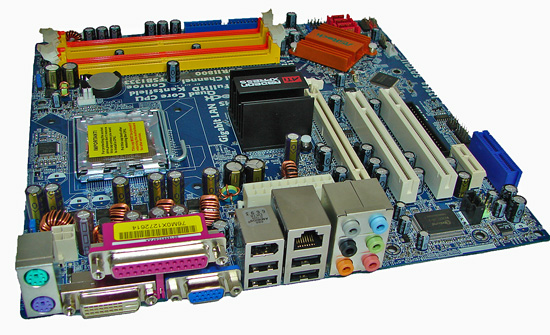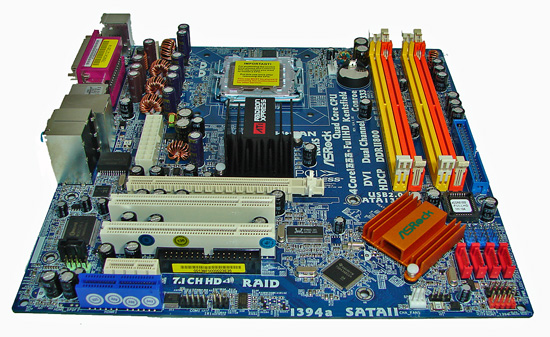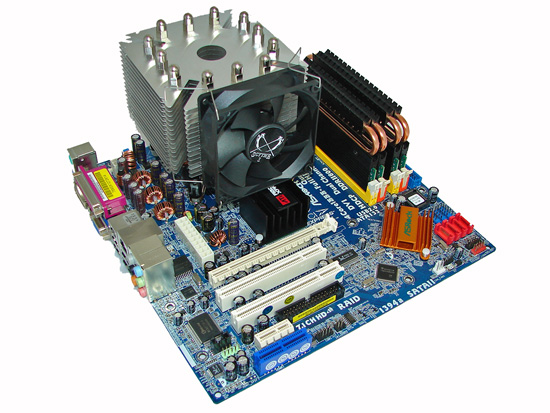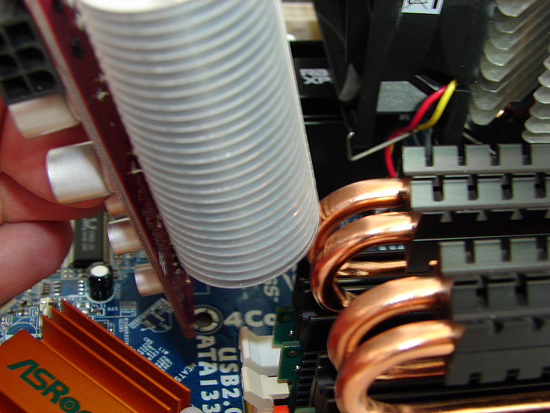µATX Part 1: ATI Radeon Xpress 1250 Performance Review
by Gary Key on August 28, 2007 7:00 AM EST- Posted in
- Motherboards
ASRock 4Core1333-FullHD: Board Layout and Features

ASRock has engineered a nice board with a good layout that only has a couple of problems. The board easily installs into a variety of micro-ATX cases and most connections are easily reached. The board features a four-phase voltage regulator system that provided excellent stability throughout our testing. Unlike the abit board that uses a combination of Conductive Polymer Aluminum Solid Capacitors and Electrolytic Capacitors, this board uses all Electrolytic Capacitors.
The board only comes with two fan headers with the CPU fan header being located to the right above the first DIMM slot. We usually prefer a minimum of three and preferably four or more fan headers on a motherboard in this category. Only the CPU fan header can be controlled via the BIOS and ASRock does not offer a Windows based utility for monitoring or controlling it.
Around the CPU socket area, we find ample room for the majority of cooling solutions. We utilized the stock heatsink/fan in our base testing but also verified several aftermarket Socket-775 cooling solutions would fit in this area during our overclocking tests. The 4-pin ATX power connector is placed on the left side of the board and did not interfere with our various cooling units.
The rear panel contains the standard PS/2 mouse and keyboard ports along with a parallel port for those who still use legacy peripherals. The panel also includes a LAN port, four USB ports, and an IEEE-1394 port. The audio panel consists of six ports that can be configured for 2, 4, 6, and 8-channel audio connections for the Realtek ALC888 HD codec. The board also has DVI and D-Sub ports for video out capabilities. If you use the DVI port, the PS/2 keyboard port will be blocked for those using a USB to PS/2 adapter.

The DIMM module slots' color coordination is correct for dual channel setup based upon the premise of installing DIMMs in the same colored slots for dual-channel operation. The memory modules are very difficult to install with a full size video card placed in the PCI Express x16 slot. The 20-pin ATX power connector is located above the Northbridge and below the IC panel. Cable routing to this location proved to be a little difficult with our Scythe Mini-Ninja cooler installed. The black floppy drive connector is located in between the last PCI slot and the PCI-E x1 slot making for an interesting cable placement if all of the slots are full.
We found the positioning of the four SB600 red SATA ports to be excellent when utilizing the PCI slots. The RS600 and SB600 chipsets are passively cooled and remained fairly cool to the touch throughout testing.
The board comes with one physical PCI Express x16 connector, one PCI Express x1 connector, two PCI 2.2 connectors, and an HDMR slot for those unfortunate enough to still be using a modem. The first PCI slot will be blocked by a dual slot graphics card. The first PCI Express x1 slot is a tight fit as a card installed in this slot will have minimal clearance between the MCH heatsink and video card.

Our choice of the Scythe Mini-Ninja heatsink for the overclocking tests was correct as it fit this board properly. Our only modification was to move the fan up slightly in order to clear the Northbridge heatsink but otherwise the unit performed very well. We will cover this in an article on building a uATX system, but this heatsink did not work on our Silverstone SG-03 mATX case due to the height restrictions. Otherwise, this heatsink worked with the majority of our cases and performed admirably.

One of the main issues we had with our selection of test components was the fact that our passively cooled MSI 8600 GTS card would not work in conjunction with our OCZ HPC Reaper memory. The heatpipes on the memory are too tall for our MSI card to fit. We had two solutions: either change the memory to a selection with a standard heat spreader design or find another 8600 GTS card. Fortunately, we had a new Galaxy 8600 GTS card that we utilized in testing on this board.

ASRock has engineered a nice board with a good layout that only has a couple of problems. The board easily installs into a variety of micro-ATX cases and most connections are easily reached. The board features a four-phase voltage regulator system that provided excellent stability throughout our testing. Unlike the abit board that uses a combination of Conductive Polymer Aluminum Solid Capacitors and Electrolytic Capacitors, this board uses all Electrolytic Capacitors.
The board only comes with two fan headers with the CPU fan header being located to the right above the first DIMM slot. We usually prefer a minimum of three and preferably four or more fan headers on a motherboard in this category. Only the CPU fan header can be controlled via the BIOS and ASRock does not offer a Windows based utility for monitoring or controlling it.
Around the CPU socket area, we find ample room for the majority of cooling solutions. We utilized the stock heatsink/fan in our base testing but also verified several aftermarket Socket-775 cooling solutions would fit in this area during our overclocking tests. The 4-pin ATX power connector is placed on the left side of the board and did not interfere with our various cooling units.
The rear panel contains the standard PS/2 mouse and keyboard ports along with a parallel port for those who still use legacy peripherals. The panel also includes a LAN port, four USB ports, and an IEEE-1394 port. The audio panel consists of six ports that can be configured for 2, 4, 6, and 8-channel audio connections for the Realtek ALC888 HD codec. The board also has DVI and D-Sub ports for video out capabilities. If you use the DVI port, the PS/2 keyboard port will be blocked for those using a USB to PS/2 adapter.

The DIMM module slots' color coordination is correct for dual channel setup based upon the premise of installing DIMMs in the same colored slots for dual-channel operation. The memory modules are very difficult to install with a full size video card placed in the PCI Express x16 slot. The 20-pin ATX power connector is located above the Northbridge and below the IC panel. Cable routing to this location proved to be a little difficult with our Scythe Mini-Ninja cooler installed. The black floppy drive connector is located in between the last PCI slot and the PCI-E x1 slot making for an interesting cable placement if all of the slots are full.
We found the positioning of the four SB600 red SATA ports to be excellent when utilizing the PCI slots. The RS600 and SB600 chipsets are passively cooled and remained fairly cool to the touch throughout testing.
The board comes with one physical PCI Express x16 connector, one PCI Express x1 connector, two PCI 2.2 connectors, and an HDMR slot for those unfortunate enough to still be using a modem. The first PCI slot will be blocked by a dual slot graphics card. The first PCI Express x1 slot is a tight fit as a card installed in this slot will have minimal clearance between the MCH heatsink and video card.

Our choice of the Scythe Mini-Ninja heatsink for the overclocking tests was correct as it fit this board properly. Our only modification was to move the fan up slightly in order to clear the Northbridge heatsink but otherwise the unit performed very well. We will cover this in an article on building a uATX system, but this heatsink did not work on our Silverstone SG-03 mATX case due to the height restrictions. Otherwise, this heatsink worked with the majority of our cases and performed admirably.

One of the main issues we had with our selection of test components was the fact that our passively cooled MSI 8600 GTS card would not work in conjunction with our OCZ HPC Reaper memory. The heatpipes on the memory are too tall for our MSI card to fit. We had two solutions: either change the memory to a selection with a standard heat spreader design or find another 8600 GTS card. Fortunately, we had a new Galaxy 8600 GTS card that we utilized in testing on this board.










22 Comments
View All Comments
Brick88 - Thursday, August 30, 2007 - link
doesn't anyone feel that AMD is cutting itself short? Yes Intel is their primary competitor but by not producing an igp chipset for intel based processors, they are cutting themselves out of a big market. Intel ships the majority of processors and AMD will need every single stream of revenue to compete with Intel.bunga28 - Wednesday, August 29, 2007 - link
Charles Dickens would roll over his grave if he saw you comparing these 2 boards by paraphrasing his work.Myrandex - Tuesday, August 28, 2007 - link
I don't knwo why they would ever put that name on the board. the fact that it is getting beat by a ASRock motherboard in gaming performance is pathetic, since that name is supposed to be all about gaming (no offense to the ASRockers out there, as they aren't bad boards I have more experience with them then fatal1ty's anyways).Etern205 - Tuesday, August 28, 2007 - link
On the "abit Fatality F-I90HD: Feature Set" page,that Abit EQ software interface of a car looks
familar one of those real models.
Like this one
<img>http://img404.imageshack.us/img404/8490/toyotafjhh...">http://img404.imageshack.us/img404/8490/toyotafjhh...
source:
http://www.automobilemag.com/new_car_previews/2006...">http://www.automobilemag.com/new_car_previews/2006...
strikeback03 - Tuesday, August 28, 2007 - link
I was thinking Hummer, either way...Etern205 - Tuesday, August 28, 2007 - link
Not really because the face of a Hummer is differentthan the one from Toyota. The face of a Hummer has
vertical grill bars, while the Toyota does not.
strikeback03 - Wednesday, August 29, 2007 - link
However the Hummer has the full-width chrome fascia, the Toyota has a part-width sorta satin chrome thing.I highly doubt they licensed an image of either, so it can't look exactly like any vehicle. I remember a lawsuit between Jeep and Hummer over the 7 vertical slots in eachother's grilles several years ago.
eBauer - Tuesday, August 28, 2007 - link
Why are the Xpress 1250 systems running tighter timings (4-4-4-12) where the G33 system is running looser timings (5-5-5-12)?strikeback03 - Tuesday, August 28, 2007 - link
Top of page 8
Mazen - Tuesday, August 28, 2007 - link
I have a 6000+ (gift) and I am just wondering whether I should go with a 690G or wait for nvidia's upcoming MCP 78. Can't wait for the 690G review... thoughts anyone?